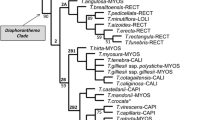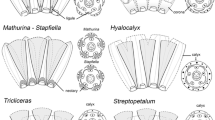Abstract
A taxometric analysis ofLimonium species in Western Europe has provided evidence for the subgeneric groupings proposed by other authors. A cluster analysis suggests that the origin of sexual and agamospermous species has taken place separately. Sexual and agamospermous species are usually clustered separately. The lack of a sexual process in many agamospermous species, as indicated by the distribution of incompatibility morphs and by very low pollen fertility, suggests that the evolution of sexual and agamospermous taxa has been by different processes. It is suggested that following the origin of agamospermous species or species groups by hybridisation, subsequent evolution in the agamospermous taxa has occurred by asexual means. Evidence from the distribution of pollen/stigma incompatibility morphs, especially the existence of self-compatible agamospermous species supports this hypothesis.
Similar content being viewed by others
References
Baker, H. G., 1953a: Race formation and reproductive method in flowering plants. — Symp. Soc. Exp. Biol.7, 114–143.
—, 1953b: Dimorphism and Monomorphism in thePlumbaginaceae. 2. The genusLimonium. — Ann. Bot., n.s.17, 433–445.
—, 1960: The evolution, functioning and breakdown of heteromorphic incompatibility systems. 1. ThePlumbaginaceae. — Evol.20, 349–368.
Bemis, W. P., Rhodes, A. M., Whitaker, T. W., Carmer, S. G., 1970: Numerical Taxonomy applied toCucurbita relationships. — Amer. J. Bot.57 (4), 404–412.
Boissier, E. P., 1848:Plumbaginaceae. — InDe Candolle, A., (Ed.): Prodr. System. Nat. Regni Veget.12, 617–696. — Paris: Victoris Masson.
Brullo, S., 1978: Il genereLimonium Miller in Cirenaica. — Webbia33(1), 137–158.
—, 1980: Taxonomic and nomenclatural notes on the genusLimonium in Sicily. — Bot. Notiser133, 281–293.
Crane, M. B., Thomas, P. T., 1939: Segregation in asexual (apomictic) offspring inRubus. — Nature143, 684–685.
Dolcher, T., Pignatti, S., 1971: Un ipotesi sull evoluzione deiLimonium de bacino del Mediterraneo. — Giorn. Bot. Ital.105(2), 95–107.
Erben, M., 1978: Die GattungLimonium im südwestmediterranen Raum. — Mitt. Bot. Staatsamm. München14, 361–631.
—, 1979: Karyotype differentiation and its consequences in MediterraneanLimonium. — Webbia34(1), 409–417.
Gustafsson, Å., 1937: Over forekornsten av en sexuell population inomTaraxacum vulgare-gruppen. — Bot. Notiser90, 332–336.
—, 1946: Apomixis in the higher plants. 1. The mechanism of apomixis. — Lunds Univ. Arsskr. N.F. Avd. 242(3), 1–66.
Heiser, C. B. Jr., Soria, J., Burton, D. L., 1965: A numerical taxonomic study ofSolanum species and hybrids. — Amer. Natur.99, 471–488.
Ingrouille, M. J., Stace, C. A., 1983: TheLimonium binervosum (G. E. Sm.)C. E. Salmon aggregate in the British Isles. — Bot. J. Linn. Soc. (accepted for publication July 1983).
Jardine, N., Sibson, R., 1976: The construction of hierarchic and non-hierarchic classifications. — Computer J.11, 177–184.
Nygren, A., 1946: The genesis of some Scandinavian species ofCalamagrostis. — Hereditas32, 131–262.
Ostenfield, C. H., 1921: Some experiments on the origin of new forms in genusHieracuum subg.Archieracium. — J. Genet.11, 117–122.
Pignatti, S., 1963: Über die Beziehungen zwischen italienischen und iberischen Arten der GattungLimonium. — Webbia18, 73–93.
—, 1971: Flora Europaea, notulae systematicae ad floram Europaeam spectantes. 11. Studi suiLimonium 8. — Bot. J. Linn. Soc.64, 361–370.
—, 1972:Limonium Miller. — InTutin, T. G., & al., (Eds.): Flora Europaea 3. — Cambridge: University Press.
Rahn, K., 1974:Plantago sect.Virginica. — Dansk Bot. Arkiv.30, 1–180.
Rollins, R. C., 1944: Evidence for genetic variation among apomictically produced plants of several Fl. progenies of Guayule (Parthenium argentatum) and Maniola (P. incanum). — Amer. J. Bot.32, 554–560.
Samuelsson, G., 1943: Die Verbreitung derAlchemilla; Arten aus dervulgaris-gruppe in Nordeuropa. — Acta Phytogeographia Suecica16, 159.
Smith, D. W., 1969: A taximetric study ofVaccinium in northeastern Ontario. — Can. J. Bot.47(11), 1747–1759.
Sneath, P. H., Sokal, R. R., 1973: Numerical Taxonomy. — San Francisco, London:W. H. Freeman & Co.
Turesson, G., 1943: Variation in the apomictic species ofAlchemilla vulgaris L. — Bot. Notiser96, 413–427.
Wishart, D., 1979: Clustan 1B. — University of Manchester Regional Computing Centre.
Author information
Authors and Affiliations
Rights and permissions
About this article
Cite this article
Ingrouille, M.J. A taxometric analysis ofLimonium (Plumbaginaceae) in Western Europe. Pl Syst Evol 147, 103–118 (1984). https://doi.org/10.1007/BF00984583
Received:
Issue Date:
DOI: https://doi.org/10.1007/BF00984583




